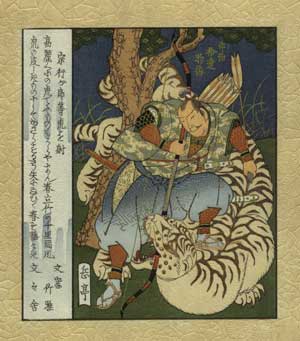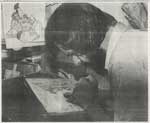Artist Recreates Surimono Woodblock Masterpieces
Fascinated by the beauty of Edo-style woodblock prints, Canadian artist David Bull began carving and printing his own versions of traditional Japanese prints almost 30 years ago, just to please himself.
Now living in Japan, Bull is one of a small group of craftsmen working to reproduce Japan's popular ukiyo-e and other woodblock prints.
In 1998, the Canadian printmaker completed a set of reproductions of Katsukawa Shunsho's illustrations for the 'Hyakunin lsshu' (One Hundred Poets), which is a collection of 100 poems by different poets. It took him 10 years to complete that project.
Since then, Bull has been working to reproduce prints called surimono, forgotten woodblock masterpieces that were privately printed and received only a small circulation among the general public, unlike the more famous ukiyo-e prints.

Next week, about 20 of Bull's delicately carved surimono wood-block prints will go on display at his annual exhibition at Gallery Shinjuku Takano in Tokyo's Shinjuku Ward. This show, called 'Surimono Albums' is Bull's second showing of his surimono prints.
Dating from the 1760s to 1860s, typical surimono style blends an image and poetry in one print.
Using fairly simple and straightforward styles, surimono themes included historical events, scenes from kabuki dramas, still-lifes and seasonal landscapes in nature.
Bull uses the same traditional techniques that the original craftsmen used, and his show will feature fine carvings and prints, including reproductions of Toyota Hokkei's Spring Fuji, Kitao Shigemasa's Yoshiwara Courtesan, Isoda Koryusai's Peony and Sparrow, Katsushika Hokusai's Soshi the Philosopher, Ando Hiroshige's Evening Rain at Eitai Bridge, Yashima Gakutei's Warrior and Tiger and many more.
TV Listings
The 'Woodblock Shimbun' has a full selection of TV programs on file. Videos available include some of David's news appearances, complete feature programs, and some short documentaries on his work. The files are in QuickTime format, and can be easily viewed with your browser.
Program listings are on the Index page ... ![]()
'Youngest' Ukiyo-e Craftsman
Ukiyoe, the Japanese art form most familiar to foreigners, was not always highly appreciated. In its earlier days during the Edo period, ukiyoe prints were used to wrap fish, similar to how people use newspaper comics to wrap garbage. Though its reputation gradually improved, mainly due to its popularity with Westerners, it may be to no avail. Ukiyoe and the traditional woodblock printmaking craft is dying in Japan. With less than 40 members in the crafts guild, all of them over 60 years old, and no apprentices, this art form is close to extinction. (1992)
Full Story. ![]()
Recapturing Edo Images
Squatting in front of a photocopy of an ukiyo-e print in the light from a 50-watt bulb, David Bull puts his carving knife carefully to a block of cherry wood. Under his blade, the image of an elaborately robed Heian minister slowly begins to emerge. "The hardest thing about making woodblock prints is the carving of intricate lines - you have to be able to use your knife like a brush in order to do justice to the fine lines," Bull says. (1989)
Full Story. ![]()
Traditional Craft, Crisis or ... ?
As a worker in the field of traditional Japanese crafts, one of the most common things I hear from visitors to my workshop is, "Isn't it a pity that wonderful crafts like this are dying out nowadays." We sometimes tend to view traditional crafts as being superior to modern ways of doing things, but I have to wonder about this. I am sure that the craftsmen of old did not view their work in special terms. I think that they were simply people 'doing a job'. (1994)
Full Story. ![]()


